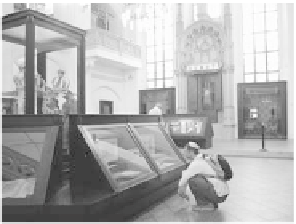Travel Reference
In-Depth Information
Planning Your Time:
The most logical start (if you'll be see-
ing everything) is to buy your ticket at Pinkas Synagogue and visit
this most powerful memorial of the museum complex first. From
there, walk through the Old Jewish Cemetery, which leads to the
Ceremonial Hall and Klaus Synagogue. After visiting those, head
over to the Old-New Synagogue, have a coffee break (Franz Kaf ka
Café, described on page 133, is nearby). Next, visit the museum-
like Maisel Synagogue, and finally the Spanish Synagogue. (Note
that Prague's fine Museum of Medieval Art, described on page 60,
is only a few blocks from the Spanish Synagogue.)
Art Nouveau and the New Josefov:
Going from sight to sight
in the Jewish Quarter, you'll walk through perhaps Europe's finest
Art Nouveau neighborhood. Make a point to enjoy the circa-1900
buildings with their marvelous trimmings and oh-wow entryways.
While today's modern grid plan has replaced the higgledy-piggledy
medieval streets of old, Široká (“Wide Street”) was and remains
the main street of the ghetto.
Pinkas Synagogue (Pinkasova Synagóga)
A site of Jewish worship for 400 years, this synagogue is a poi-
gnant memorial to the victims of the Nazis. The walls are covered
with the handwritten names of
77,297 Czech Jews who were sent
from here to the gas chambers at
Auschwitz and other camps. (As
you ponder this sad sight, you'll
hear the somber reading of the
names alternating with a cantor
singing the Psalms.) Hometowns
are in gold and family names are
in red, followed in black by the
individual's first name, birthday, and last date known to be alive.
Notice that families generally perished together. Extermination
camps are listed on the east wall. Climb eight steps into the
women's gallery. When the communists moved in, they closed
the synagogue and erased virtually everything. With freedom,
in 1989, the Pinkas Synagogue was reopened and the names
were rewritten. (The names in poor condition near the ceiling
are original.) Note that large tour groups may disturb this small
memorial's compelling atmosphere between 10:00 and 12:00.
Upstairs is the
Terezín Children's Art Exhibit
(very well-
described in English), displaying art drawn by Jewish children
who were imprisoned at Terezín Concentration Camp and later
perished. Terezín makes an emotionally moving day trip from
Prague; it's easily accessible by local bus (see page 170) or tour bus
(see page 49).




















